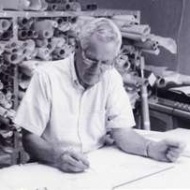Theodore (Ted) G. Robinson, a past president of the American Society of Golf Course Architects, died in March 2008 at his home in Laguna Beach, California after a ten-month battle with pancreatic cancer. He was eighty-four. Robinson served as ASGCA President from 1983 to 1984. With an architectural career spanning over five decades, Robinson is credited with over  160 projects that bear his influence, including courses in the Western United States, Hawaii, Mexico, Japan, Korea, and Indonesia. In 1954, Robinson established his own practice concentrated in golf course design, land planning, and subdivision and park design. Robinson spent the majority of his career working independently while wife Bobbi managed the office, until 1991 when son, Ted Jr., joined the practice. Dubbed the “King of Waterscapes,” Robinson endorsed the use of water as a defining hazard for course designs. Robinson was also widely recognized for his golf-oriented master planned community, Mesa Verde, in Costa Mesa, as well as twenty-six separate golf course architecture projects in the Palm Springs and Palm Desert area alone, including Sunrise, Monterey, Palm Valley, The Lakes, Indian Wells, Ironwood, Tahquitz Creek and Desert Springs. One of Robinson’s most beloved projects was Sahalee Country Club in Redmond, Washington, which hosted the PGA Tour Championship in 1998. Other notable courses include Tijeras Creek and Tustin Ranch in Orange County, California; the Experience in Koele on the island of Lanai, Hawaii; and Robinson Ranch in Santa Clarita, California, a project designed and developed jointly with his son and named in his honor.
160 projects that bear his influence, including courses in the Western United States, Hawaii, Mexico, Japan, Korea, and Indonesia. In 1954, Robinson established his own practice concentrated in golf course design, land planning, and subdivision and park design. Robinson spent the majority of his career working independently while wife Bobbi managed the office, until 1991 when son, Ted Jr., joined the practice. Dubbed the “King of Waterscapes,” Robinson endorsed the use of water as a defining hazard for course designs. Robinson was also widely recognized for his golf-oriented master planned community, Mesa Verde, in Costa Mesa, as well as twenty-six separate golf course architecture projects in the Palm Springs and Palm Desert area alone, including Sunrise, Monterey, Palm Valley, The Lakes, Indian Wells, Ironwood, Tahquitz Creek and Desert Springs. One of Robinson’s most beloved projects was Sahalee Country Club in Redmond, Washington, which hosted the PGA Tour Championship in 1998. Other notable courses include Tijeras Creek and Tustin Ranch in Orange County, California; the Experience in Koele on the island of Lanai, Hawaii; and Robinson Ranch in Santa Clarita, California, a project designed and developed jointly with his son and named in his honor.
In the early 1970’s, I was introduced to a man named Omori. He was looking to hire an American golf course architect. After an extensive interview, he invited my wife and I to Japan for several days to see his existing golf course and meet about what I thought was his proposed course. I had never been to Japan and welcomed the opportunity to go as his guest.
Upon arrival in Tokyo, we were picked up by Mr. Omori and his interpreter. After about an hour of travel, we ended up in an area of beautiful open country south of Mount Fuji. We were headed toward his country club and what I assumed to be the site of his proposed course. As we got closer to the club the roads became narrower, making it difficult to pass oncoming traffic. We drove to the clubhouse and could see a beautiful golf course full of players on the left side, and on the right side, a mountainous parcel of land with about 50 pieces of grading equipment attacking the hills.
“What are the workers doing?” I asked Mr. Omori.
“They are grading my new golf course,” he replied.
I was puzzled.
“If the course is under construction, why am I here?”
Mr. Omori quickly replied, “You design.”
I then became extremely confused. Here I was in a foreign country, without a contract or any type of agreement, and Mr. Omori was ready for me to go to work!
Later that day, I met with Mr. Omori to find out what maps they had. The only map available was a mass grading plan. Armed with this bit of information, I walked the site and came up with a rough routing plan, but was unsure what to do next. I could look out the window of the clubhouse and see the lights of the tractors as they worked twenty-four hours a day. The subcontractors did not understand English, so how would they know what I might have them do?
I had an idea. I would build for them a sand model showing how a particular hole needed to look.
The next morning they brought me a large, flat, four-foot by six-foot box filled with sand, and I went to work getting my hands dirty. That evening Mr. Omori brought his engineers and tractor operators into the boardroom to look at the model I’d shaped by hand. I couldn’t understand a word, but I got the impression they understood what it the hole should look like. By the next morning, they had the entire fairway graded the way I had modeled it. After breakfast, I watched as they brought in seventeen more boxes and I spent the next couple of days playing in the sand. The entire course was designed in that fashion!
From the time construction began to the time the course opened for play, only five months passed. They did all of it by working twenty-four hours a day, seven days a week. Six-hundred Japanese women worked down each fairway; the first row picked up rocks and smoothed the surface, and a second row followed shoulder to shoulder laying sod.
The literally handmade club, Lakewood Golf Club, has become very successful with memberships selling at over $1 million.
So much for drawing and computer models!
